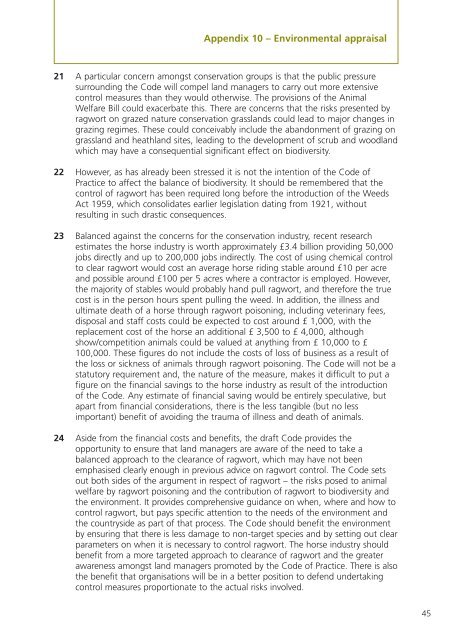code of practice on hopw to prevent the spread of ragwort - Defra
code of practice on hopw to prevent the spread of ragwort - Defra
code of practice on hopw to prevent the spread of ragwort - Defra
You also want an ePaper? Increase the reach of your titles
YUMPU automatically turns print PDFs into web optimized ePapers that Google loves.
Appendix 10 – Envir<strong>on</strong>mental appraisal<br />
21 A particular c<strong>on</strong>cern am<strong>on</strong>gst c<strong>on</strong>servati<strong>on</strong> groups is that <strong>the</strong> public pressure<br />
surrounding <strong>the</strong> Code will compel land managers <strong>to</strong> carry out more extensive<br />
c<strong>on</strong>trol measures than <strong>the</strong>y would o<strong>the</strong>rwise. The provisi<strong>on</strong>s <str<strong>on</strong>g>of</str<strong>on</strong>g> <strong>the</strong> Animal<br />
Welfare Bill could exacerbate this. There are c<strong>on</strong>cerns that <strong>the</strong> risks presented by<br />
<strong>ragwort</strong> <strong>on</strong> grazed nature c<strong>on</strong>servati<strong>on</strong> grasslands could lead <strong>to</strong> major changes in<br />
grazing regimes. These could c<strong>on</strong>ceivably include <strong>the</strong> aband<strong>on</strong>ment <str<strong>on</strong>g>of</str<strong>on</strong>g> grazing <strong>on</strong><br />
grassland and heathland sites, leading <strong>to</strong> <strong>the</strong> development <str<strong>on</strong>g>of</str<strong>on</strong>g> scrub and woodland<br />
which may have a c<strong>on</strong>sequential significant effect <strong>on</strong> biodiversity.<br />
22 However, as has already been stressed it is not <strong>the</strong> intenti<strong>on</strong> <str<strong>on</strong>g>of</str<strong>on</strong>g> <strong>the</strong> Code <str<strong>on</strong>g>of</str<strong>on</strong>g><br />
Practice <strong>to</strong> affect <strong>the</strong> balance <str<strong>on</strong>g>of</str<strong>on</strong>g> biodiversity. It should be remembered that <strong>the</strong><br />
c<strong>on</strong>trol <str<strong>on</strong>g>of</str<strong>on</strong>g> <strong>ragwort</strong> has been required l<strong>on</strong>g before <strong>the</strong> introducti<strong>on</strong> <str<strong>on</strong>g>of</str<strong>on</strong>g> <strong>the</strong> Weeds<br />
Act 1959, which c<strong>on</strong>solidates earlier legislati<strong>on</strong> dating from 1921, without<br />
resulting in such drastic c<strong>on</strong>sequences.<br />
23 Balanced against <strong>the</strong> c<strong>on</strong>cerns for <strong>the</strong> c<strong>on</strong>servati<strong>on</strong> industry, recent research<br />
estimates <strong>the</strong> horse industry is worth approximately £3.4 billi<strong>on</strong> providing 50,000<br />
jobs directly and up <strong>to</strong> 200,000 jobs indirectly. The cost <str<strong>on</strong>g>of</str<strong>on</strong>g> using chemical c<strong>on</strong>trol<br />
<strong>to</strong> clear <strong>ragwort</strong> would cost an average horse riding stable around £10 per acre<br />
and possible around £100 per 5 acres where a c<strong>on</strong>trac<strong>to</strong>r is employed. However,<br />
<strong>the</strong> majority <str<strong>on</strong>g>of</str<strong>on</strong>g> stables would probably hand pull <strong>ragwort</strong>, and <strong>the</strong>refore <strong>the</strong> true<br />
cost is in <strong>the</strong> pers<strong>on</strong> hours spent pulling <strong>the</strong> weed. In additi<strong>on</strong>, <strong>the</strong> illness and<br />
ultimate death <str<strong>on</strong>g>of</str<strong>on</strong>g> a horse through <strong>ragwort</strong> pois<strong>on</strong>ing, including veterinary fees,<br />
disposal and staff costs could be expected <strong>to</strong> cost around £ 1,000, with <strong>the</strong><br />
replacement cost <str<strong>on</strong>g>of</str<strong>on</strong>g> <strong>the</strong> horse an additi<strong>on</strong>al £ 3,500 <strong>to</strong> £ 4,000, although<br />
show/competiti<strong>on</strong> animals could be valued at anything from £ 10,000 <strong>to</strong> £<br />
100,000. These figures do not include <strong>the</strong> costs <str<strong>on</strong>g>of</str<strong>on</strong>g> loss <str<strong>on</strong>g>of</str<strong>on</strong>g> business as a result <str<strong>on</strong>g>of</str<strong>on</strong>g><br />
<strong>the</strong> loss or sickness <str<strong>on</strong>g>of</str<strong>on</strong>g> animals through <strong>ragwort</strong> pois<strong>on</strong>ing. The Code will not be a<br />
statu<strong>to</strong>ry requirement and, <strong>the</strong> nature <str<strong>on</strong>g>of</str<strong>on</strong>g> <strong>the</strong> measure, makes it difficult <strong>to</strong> put a<br />
figure <strong>on</strong> <strong>the</strong> financial savings <strong>to</strong> <strong>the</strong> horse industry as result <str<strong>on</strong>g>of</str<strong>on</strong>g> <strong>the</strong> introducti<strong>on</strong><br />
<str<strong>on</strong>g>of</str<strong>on</strong>g> <strong>the</strong> Code. Any estimate <str<strong>on</strong>g>of</str<strong>on</strong>g> financial saving would be entirely speculative, but<br />
apart from financial c<strong>on</strong>siderati<strong>on</strong>s, <strong>the</strong>re is <strong>the</strong> less tangible (but no less<br />
important) benefit <str<strong>on</strong>g>of</str<strong>on</strong>g> avoiding <strong>the</strong> trauma <str<strong>on</strong>g>of</str<strong>on</strong>g> illness and death <str<strong>on</strong>g>of</str<strong>on</strong>g> animals.<br />
24 Aside from <strong>the</strong> financial costs and benefits, <strong>the</strong> draft Code provides <strong>the</strong><br />
opportunity <strong>to</strong> ensure that land managers are aware <str<strong>on</strong>g>of</str<strong>on</strong>g> <strong>the</strong> need <strong>to</strong> take a<br />
balanced approach <strong>to</strong> <strong>the</strong> clearance <str<strong>on</strong>g>of</str<strong>on</strong>g> <strong>ragwort</strong>, which may have not been<br />
emphasised clearly enough in previous advice <strong>on</strong> <strong>ragwort</strong> c<strong>on</strong>trol. The Code sets<br />
out both sides <str<strong>on</strong>g>of</str<strong>on</strong>g> <strong>the</strong> argument in respect <str<strong>on</strong>g>of</str<strong>on</strong>g> <strong>ragwort</strong> – <strong>the</strong> risks posed <strong>to</strong> animal<br />
welfare by <strong>ragwort</strong> pois<strong>on</strong>ing and <strong>the</strong> c<strong>on</strong>tributi<strong>on</strong> <str<strong>on</strong>g>of</str<strong>on</strong>g> <strong>ragwort</strong> <strong>to</strong> biodiversity and<br />
<strong>the</strong> envir<strong>on</strong>ment. It provides comprehensive guidance <strong>on</strong> when, where and how <strong>to</strong><br />
c<strong>on</strong>trol <strong>ragwort</strong>, but pays specific attenti<strong>on</strong> <strong>to</strong> <strong>the</strong> needs <str<strong>on</strong>g>of</str<strong>on</strong>g> <strong>the</strong> envir<strong>on</strong>ment and<br />
<strong>the</strong> countryside as part <str<strong>on</strong>g>of</str<strong>on</strong>g> that process. The Code should benefit <strong>the</strong> envir<strong>on</strong>ment<br />
by ensuring that <strong>the</strong>re is less damage <strong>to</strong> n<strong>on</strong>-target species and by setting out clear<br />
parameters <strong>on</strong> when it is necessary <strong>to</strong> c<strong>on</strong>trol <strong>ragwort</strong>. The horse industry should<br />
benefit from a more targeted approach <strong>to</strong> clearance <str<strong>on</strong>g>of</str<strong>on</strong>g> <strong>ragwort</strong> and <strong>the</strong> greater<br />
awareness am<strong>on</strong>gst land managers promoted by <strong>the</strong> Code <str<strong>on</strong>g>of</str<strong>on</strong>g> Practice. There is also<br />
<strong>the</strong> benefit that organisati<strong>on</strong>s will be in a better positi<strong>on</strong> <strong>to</strong> defend undertaking<br />
c<strong>on</strong>trol measures proporti<strong>on</strong>ate <strong>to</strong> <strong>the</strong> actual risks involved.<br />
45
















